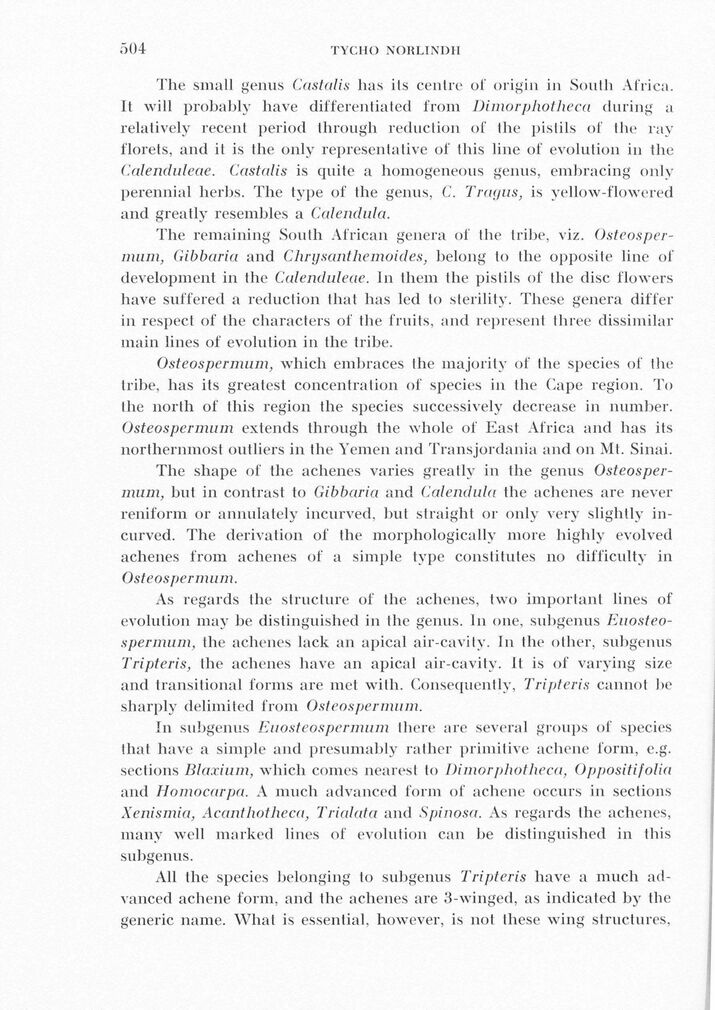
Full resolution (JPEG) - On this page / på denna sida - Sidor ...

<< prev. page << föreg. sida << >> nästa sida >> next page >>
Below is the raw OCR text
from the above scanned image.
Do you see an error? Proofread the page now!
Här nedan syns maskintolkade texten från faksimilbilden ovan.
Ser du något fel? Korrekturläs sidan nu!
This page has never been proofread. / Denna sida har aldrig korrekturlästs.
504
TYCHO NOR LINDH
The small genus Castalis has ils centre öl’ origin in Soulh Africa.
It will probably have differentiated from Dimorphotheca elming a
relatively recent period through reduction of the pislils of Ihe ray
florets, and il is the onlv representative of this line of evolution in the
Calenduleae. Castalis is quite a homogeneous genus, embracing onlv
perennial herbs. The type of the genus, C. Tra/jus, is vellow-flowered
and greatly resembles a Calendula.
The remaining South African genera of the Iribe, viz.
Osteospermum, Gibbaria and C hr i) sant hemoides, belong lo Ihe opposite line of
development in the Calenduleae. In t hem Ihe pistils of the disc flowers
have suffered a reduction that has led to slerility. These genera differ
in respect of Ihe characters of the fruits, and represent three dissimilar
main lines of evolution in the tribe.
Osteospermum, which embraces the majority of the species of the
tribe, has its greatest concentration of species in the Cape region. To
the north of this region the species successively decrease in number.
Osteospermum extends through the whole of East Africa and has its
northernmost outliers in the Yemen and Transjordania and ön Ml. Sinai.
The shape of the achenes varies greatly in the genus
Osteospermum, but in contrast to Gibbaria and Calendula the achenes are never
reniform or annulately incurved. but straight or onlv verv slightly
in-curved. The derivation of the morphologically möre highly evolved
achenes from achenes of a simple tvpe constitutes no difficulty in
Osteospermum.
As regards the structure of the achenes, two important lines of
evolution may be distinguished in the genus. In one, subgenus
Euosteo-spermum, the achenes lack an apical air-cavity. In the other, subgenus
Tripteris, the achenes have an apical air-cavity. Jt is of varying si/e
and transitional forms are met with. Consequently, Tripteris cannot be
sharply delimited from Osteospermum.
In subgenus Euosteospcrmum there are several groups of species
|bat have a simple and presumably rather primitive achene form, e.g.
sections Blaxium, which comes nearesl to Dimorphotheca, Oppositifolia
and Homocarpa. A much advanced form of achene occurs in sections
Xenismia, Acanthotheca, TriaUda and Spinosa. As regards the achenes,
many well marked lines of evolution can be distinguished in this
subgenus.
All the species belonging to subgenus Tripteris have a much
advanced achene form, and the achenes are 3-winged, as indicated bv the
generic name. What is essenlial, however, is nol lliese wing structures,
<< prev. page << föreg. sida << >> nästa sida >> next page >>